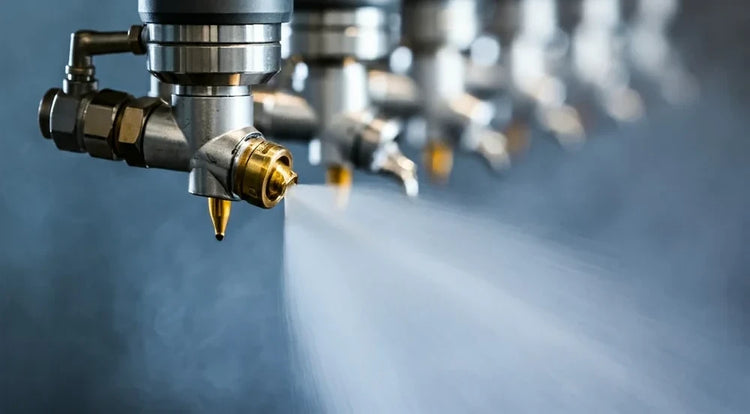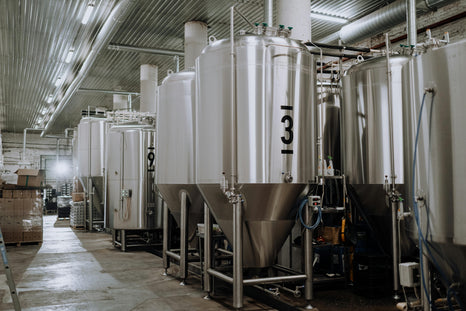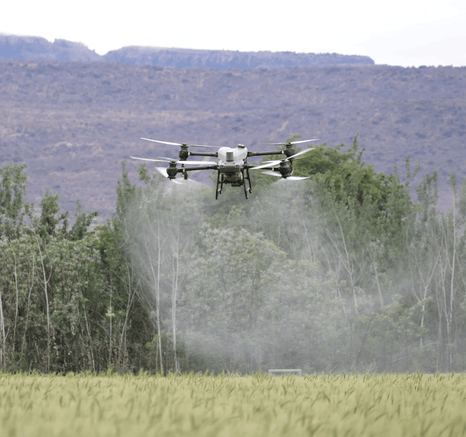Cleaning tanks and equipment efficiently is no small task, especially in industries like food production, pharmaceuticals, and brewing. That’s where CIP spray ball nozzles come into play. These tools are all about making the cleaning process faster, more reliable, and less wasteful. If you’ve ever wondered how these nozzles work, why they matter, or how to pick the right one, this guide is for you.
Key Takeaways
- CIP spray ball nozzles are essential for cleaning tanks and equipment in various industries.
- Choosing the right nozzle depends on factors like tank size, cleaning requirements, and industry standards.
- Modern nozzles offer eco-friendly designs that save water and chemicals.
- Regular maintenance can extend the lifespan of your nozzles and prevent common issues.
- Understanding spray patterns and flow rates helps optimize cleaning performance.
What Are CIP Spray Ball Nozzles?
CIP (Clean-In-Place) spray ball nozzles are devices designed to clean the interiors of tanks and vessels without requiring disassembly. These nozzles distribute cleaning solutions in a controlled spray pattern, ensuring every surface inside the tank is reached. By automating the cleaning process, they save time and reduce manual labor.
Key features of CIP spray ball nozzles include:
- Uniform spray coverage for thorough cleaning.
- Compatibility with various cleaning solutions.
- Easy integration into existing CIP systems.
Key Components of a CIP Spray Ball System
A CIP spray ball system typically includes several essential parts that work together to deliver effective cleaning. These components include:
|
Component |
Purpose |
|
Spray Ball Nozzle |
Distributes cleaning solution uniformly. |
|
Pump |
Supplies the necessary pressure. |
|
Piping System |
Directs the cleaning solution. |
|
Control Unit |
Regulates pressure and flow rate. |
Each part plays a role in ensuring the system operates efficiently and meets hygiene standards.
How Spray Ball Nozzles Work in Tank Cleaning
The working principle of spray ball nozzles is fairly straightforward. Cleaning solutions are pumped through the nozzle, which sprays them in a specific pattern to cover the tank's interior. The spray pattern can vary depending on the nozzle design and the cleaning requirements.
Steps in the cleaning process:
- The tank is drained of its contents.
- Cleaning solution is pumped through the spray ball nozzle.
- The solution is sprayed in a 360-degree pattern to reach all surfaces.
- Rinsing is done to remove residual cleaning agents.
A well-designed spray ball nozzle ensures consistent cleaning while minimizing water and chemical usage.
The efficiency of this process makes CIP spray ball nozzles a popular choice in industries like food and beverage, pharmaceuticals, and chemical manufacturing.
Factors to Consider When Selecting Nozzles
Picking the right CIP spray ball nozzle isn’t just about grabbing the first one you see. The right choice can make or break your cleaning process. Here are some things to think about:
- Tank Size and Shape: A larger tank might need a rotating nozzle for better coverage, while smaller tanks might do fine with a static spray ball.
- Cleaning Requirements: Are you washing away thick residues or just rinsing? Different nozzles handle different jobs.
- Material Compatibility: Make sure the nozzle material won’t corrode or react with the tank contents.
Industry-Specific Applications of Spray Ball Nozzles
Each industry has its quirks when it comes to cleaning. Here’s how spray ball nozzles fit in:
- Food and Beverage: These industries often use rotating spray balls to meet hygiene standards.
-
Pharmaceuticals: Static spray balls are common here, as they’re simple and reliable for non-viscous cleaning tasks.
Comparing Fixed and Rotating Spray Ball Nozzles
Both types have their pros and cons:
|
Feature |
Fixed Nozzles |
Rotating Nozzles |
|
Cleaning Coverage |
Limited, good for simple tasks |
Excellent, covers complex shapes |
|
Maintenance |
Low, fewer moving parts |
Higher, needs regular checks |
|
Water Usage |
More water needed |
More efficient |
Choosing between fixed and rotating nozzles depends largely on your cleaning challenges and budget. Don’t overthink it—sometimes simple is better!
The Role of Spray Patterns in Cleaning Performance
Spray patterns are more than just water distribution—they determine how well surfaces are cleaned. A well-designed spray pattern ensures even coverage, reducing the risk of residue buildup. The key is to match the spray pattern to the tank's geometry. For example, a spherical tank benefits from a 360-degree spray pattern, while cylindrical tanks may need a more targeted approach.
Impact of Nozzle Pressure and Flow Rate
Pressure and flow rate are like the gas pedal and steering wheel of cleaning efficiency—they need to work together. Low pressure might save water, but it could leave grime behind. Meanwhile, excessive pressure can damage delicate surfaces. Balancing these factors ensures effective cleaning without overusing resources. A good rule of thumb? Opt for a nozzle that offers adjustable settings.
Reducing Water and Chemical Usage with Efficient Nozzles
Modern CIP spray ball nozzles are designed to cut down on waste. By optimizing spray angles and flow rates, they use less water and fewer chemicals without compromising on cleanliness. Here’s a quick comparison:
|
Feature |
Traditional Nozzles |
Modern CIP Nozzles |
|
Water Usage |
High |
Low |
|
Chemical Efficiency |
Moderate |
High |
|
Cleaning Time |
Long |
Short |
Efficient nozzles are not just about saving money; they also contribute to sustainability by reducing resource consumption.
Eco-Friendly Features in Modern Nozzles
Modern CIP spray ball nozzles are being designed with sustainability in mind. Energy-efficient designs now focus on reducing water consumption without compromising cleaning performance. Materials like stainless steel are being replaced or supplemented with recyclable and eco-friendly alternatives. Additionally, some nozzles now include features that minimize chemical usage, which not only saves costs but also reduces environmental impact.
Advancements in Rotating Spray Ball Technology
Rotating spray ball nozzles have seen significant upgrades in recent years. These advancements include:
- Improved Bearing Systems: New designs use low-friction bearings, enhancing rotation even under low-pressure conditions.
- Precision Spray Patterns: Innovations have led to more targeted cleaning, ensuring every corner of the tank is reached.
- Durability Enhancements: Materials that resist wear and tear from constant rotation and chemical exposure are now the standard.
Customizing Nozzles for Unique Cleaning Needs
Industries have unique challenges, and one-size-fits-all nozzles often fall short. Customizable CIP nozzles allow businesses to tailor spray angles, flow rates, and even materials to suit specific requirements. For example:
|
Industry |
Customization Focus |
|
Food & Beverage |
Hygiene and residue removal |
|
Pharmaceuticals |
Sterility and precision |
|
Chemical Processing |
Corrosion resistance |
Customizable options ensure that nozzles are not just tools but solutions tailored to your cleaning challenges.
Maintaining and Troubleshooting CIP Spray Ball Nozzles
CIP spray ball nozzles are reliable, but like any mechanical component, they can run into problems. Clogging is the most frequent issue, often caused by residue buildup inside the nozzle. To fix this:
- Disassemble the nozzle carefully.
- Use a soft brush or compressed air to clear debris.
- Inspect for damage to the nozzle's holes or surface.
Other common issues include uneven spray patterns and leaks. Uneven spraying might mean the nozzle is worn out or installed incorrectly. Leaks often stem from loose fittings or worn seals. Replacing gaskets and tightening connections usually solves the problem.
Extending the Lifespan of Your Nozzles
Proper maintenance can help your CIP spray ball nozzles last longer. Here are some tips:
- Rinse thoroughly: After every cleaning cycle, flush the nozzles with clean water to prevent residue buildup.
- Perform regular checks for wear and tear, especially on seals and spray holes.
- Avoid using harsh chemicals that could corrode the nozzle material.
Keeping a maintenance log can also be helpful. Record when nozzles are cleaned, inspected, or replaced to ensure nothing gets overlooked.
Best Practices for Regular Maintenance
Routine maintenance is key to keeping your nozzles in top shape. Follow these best practices:
- Schedule periodic inspections, ideally after every cleaning cycle or weekly, depending on usage.
- Replace seals and gaskets at the first sign of wear.
- Store spare nozzles and parts in a clean, dry place to ensure quick replacements when needed.
Regular care not only saves money but also ensures that your CIP system operates efficiently without unexpected downtime.
For a deeper understanding of the differences between static and dynamic spray balls, check out this comparison to see which setup might work best for you.
Understanding the Physics of Spray Ball Cleaning
CIP spray ball nozzles rely on basic physics to deliver effective cleaning. The nozzle’s spray pattern disperses liquid at specific angles, ensuring that every inch of the tank’s interior is reached. This even distribution is key to removing residue and biofilms. The cleaning effectiveness depends on the kinetic energy of the spray, which is influenced by the pressure and flow rate of the cleaning solution.
Key factors include:
- Impact force: Higher pressure increases the cleaning power, ideal for stubborn residues.
- Coverage: Nozzles are designed to ensure maximum reach within the tank.
- Flow dynamics: Uniform flow ensures consistent cleaning without missed spots.
How Nozzle Size Affects Cleaning Efficiency
The size of a CIP spray ball nozzle isn’t just about fitting into the tank. It directly affects cleaning efficiency. Smaller nozzles are great for compact tanks but might lack the pressure needed for larger setups. Larger nozzles, on the other hand, handle higher volumes of cleaning fluid but may require more energy.
|
Nozzle Size |
Best For |
Considerations |
|
Small |
Compact tanks, light residues |
May need higher pressure |
|
Medium |
General-purpose cleaning |
Balanced efficiency |
|
Large |
Large tanks, heavy residues |
Higher energy use |
The Link Between Spray Ball Design and Hygiene Standards
Hygiene is non-negotiable in industries like food and pharmaceuticals. Spray ball designs must meet strict standards to ensure no residue or contaminants remain. Features like smooth surfaces and self-draining capabilities help maintain cleanliness. Additionally, the design’s ability to pass validation tests, such as the Riboflavin test, ensures comprehensive cleaning even in hard-to-reach areas.
A well-designed spray ball nozzle not only cleans effectively but also minimizes the risk of contamination, making it a vital component in maintaining hygiene standards.
Benefits of Automation in Tank Cleaning
Automating tank cleaning with CIP spray ball nozzles can save time and labor while ensuring consistent results. Automation eliminates human error, providing repeatable cleaning cycles that meet strict industry standards. Key benefits include:
- Reduced cleaning time, leading to higher productivity.
- Improved safety by minimizing human exposure to cleaning agents.
- Consistent cleaning quality, essential for industries like food and pharmaceuticals.
Key Features of Automated CIP Systems
Modern automated CIP systems are equipped with advanced features to optimize cleaning processes. Some of these include:
- Programmable Logic Controllers (PLCs) to manage cleaning sequences.
- Sensors for monitoring flow rate, pressure, and temperature in real-time.
- Automated valves to switch between cleaning cycles like rinsing, washing, and sanitizing.
These features ensure that every cleaning cycle is efficient and meets hygiene standards.
Ensuring Compatibility with Existing Equipment
Integrating CIP spray ball nozzles into an existing setup requires careful planning. Consider the following steps:
- Assess the compatibility of your current tanks and piping systems.
- Verify that the spray ball nozzles meet the required pressure and flow specifications.
- Consult with equipment manufacturers to ensure seamless integration.
Upgrading to an automated system might seem complex, but the long-term savings in time, labor, and resources make it a worthwhile investment.
Wrapping It Up
CIP spray ball nozzles might not be the flashiest part of your cleaning setup, but they sure do a lot of heavy lifting. Whether you're dealing with food tanks, chemical vats, or industrial equipment, these little tools make cleaning faster, easier, and more consistent. By picking the right nozzle and keeping it in good shape, you can save time, cut costs, and even help the environment by using less water and chemicals. So, if you haven't already, it's worth giving your cleaning process a second look. A small change here could make a big difference in the long run.












